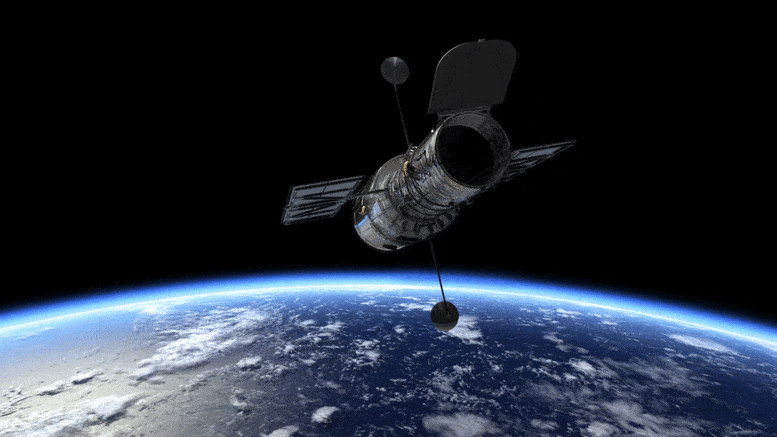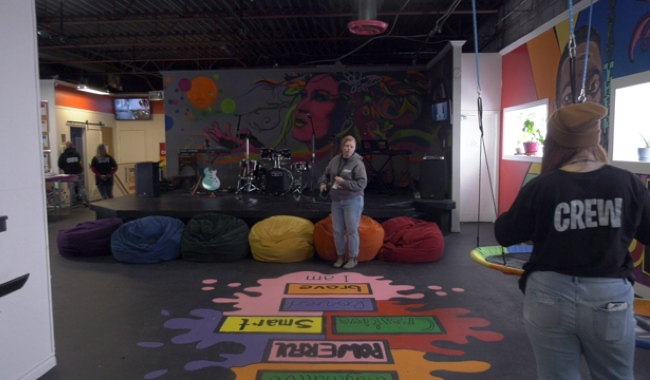Animacja 3D przedstawiająca Kosmiczny Teleskop Hubble’a nad Ziemią. Źródło: ESA/Hubble (M. Kornmesser i LL Christensen)
Nowy projekt chodzącego robota
Naukowcy stworzyli zaawansowanego robota mobilnego, który może zrewolucjonizować projekty budowlane na dużą skalę. Przetestowali wykonalność robota do montażu 25-metrowego teleskopu kosmicznego o dużej aperturze w kosmosie. Ich odkrycia zostały niedawno opublikowane w czasopiśmie Granice w robotyce i sztucznej inteligencji. Co więcej, miniaturowa wersja robota wykazała potencjał zastosowań budowlanych na dużą skalę na Ziemi.
Konserwacja i konserwacja masywnych konstrukcji jest szczególnie ważna w kosmosie, gdzie panują ekstremalne warunki, a ludzka technologia ma ograniczoną żywotność. Robotyka, systemy autonomiczne i działania poza pojazdami okazały się przydatne w misjach serwisowych i konserwacyjnych oraz pomogły społeczności kosmicznej w prowadzeniu innowacyjnych badań nad różnymi misjami kosmicznymi. Robotyka i systemy autonomiczne zapewniają szeroki zakres usług w przestrzeni kosmicznej. Obejmuje to między innymi produkcję, montaż, konserwację, astronomię, obserwacje naziemne i usuwanie gruzu.
Ze względu na wiele zagrożeń poleganie wyłącznie na ludzkich budowniczych jest niewystarczające, a obecne technologie są przestarzałe.
„Musimy wprowadzić zrównoważoną i przyszłościową technologię, aby wspierać istniejący i rozwijający się ekosystem tropikalny” – wyjaśnił dr Manu Nair, odpowiedni autor. przefiltrować Uniwersytet Lincolna.
„Wraz ze wzrostem rozmiarów misji kosmicznych istnieje zapotrzebowanie na bardziej rozbudowaną infrastrukturę na orbicie. Misje montażowe w kosmosie będą miały jeden z głównych obowiązków w zakresie zaspokojenia rosnącego popytu.”
Nair i współpracownicy przedstawiają w swoim artykule nowy, genialny robotyczny system chodzenia, który może być używany do misji zbierania na orbicie. Jako przypadek użycia, naukowcy przetestowali robota do montażu 25-metrowego teleskopu kosmicznego o dużej aperturze (LAST).
Montaż teleskopów na orbicie
od uruchomienia[{” attribute=””>Hubble Space Telescope and its successor, the James Webb Space Telescope, the space community has been continuously moving towards deploying newer and larger telescopes with larger apertures (the diameter of the light collecting region).
Assembling such telescopes, such as a 25m LAST, on Earth is not possible with our current launch vehicles due to their limited size. That is why larger telescopes ideally need to be assembled in space (or in orbit).
“The prospect of in-orbit commissioning of a LAST has fueled scientific and commercial interests in deep-space astronomy and Earth observation,” said Nair.
To assemble a telescope of that magnitude in space, we need the right tools: “Although conventional space-walking robotic candidates are dexterous, they are constrained in maneuverability. Therefore, it is significant for future in-orbit walking robot designs to incorporate mobility features to offer access to a much larger workspace without compromising dexterity.”
E-Walker robot
The researchers proposed a seven degrees-of-freedom fully dexterous end-over-end walking robot (a limbed robotic system that can move along a surface to different locations to perform tasks with seven degrees of motion capabilities), or, in short, an E-Walker.
They conducted an in-depth design engineering exercise to test the robot for its capabilities to efficiently assemble a 25m LAST in orbit. The robot was compared to the existing Canadarm2 and the European Robotic Arm on the International Space Station. Additionally, a scaled-down prototype for Earth-analog testing was developed and another design engineering exercise was performed.
“Our analysis shows that the proposed innovative E-Walker design proves to be versatile and an ideal candidate for future in-orbit missions. The E-Walker would be able to extend the life cycle of a mission by carrying out routine maintenance and servicing missions post assembly, in space” explained Nair.
“The analysis of the scaled-down prototype identifies it to also be an ideal candidate for servicing, maintenance, and assembly operations on Earth, such as carrying out regular maintenance checks on wind turbines.”
Yet a lot remains to be explored. The research was limited to the design engineering analysis of a full-scale and prototype model of the E-Walker. Nair explained: “The E-Walker prototyping work is now in progress at the University of Lincoln; therefore, the experimental verification and validation will be published separately.”
Reference: “Design engineering a walking robotic manipulator for in-space assembly missions” by Manu Harikrishnan Nair, Mini Chakravarthini Rai and Mithun Poozhiyil, 14 October 2022, Frontiers in Robotics and AI.
DOI: 10.3389/frobt.2022.995813

„Analityk. Nieuleczalny nerd z bekonu. Przedsiębiorca. Oddany pisarz. Wielokrotnie nagradzany alkoholowy ninja. Subtelnie czarujący czytelnik.”




